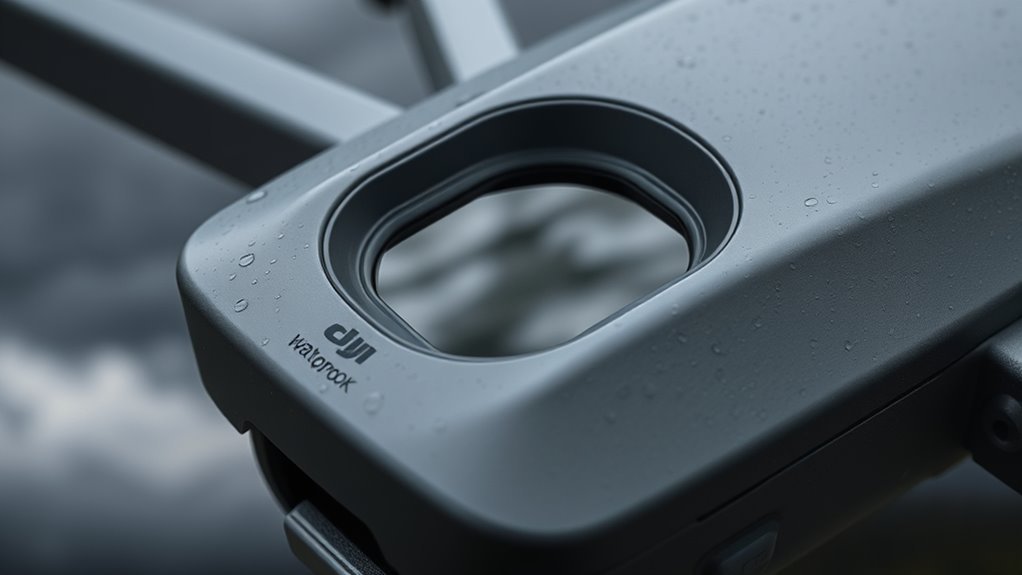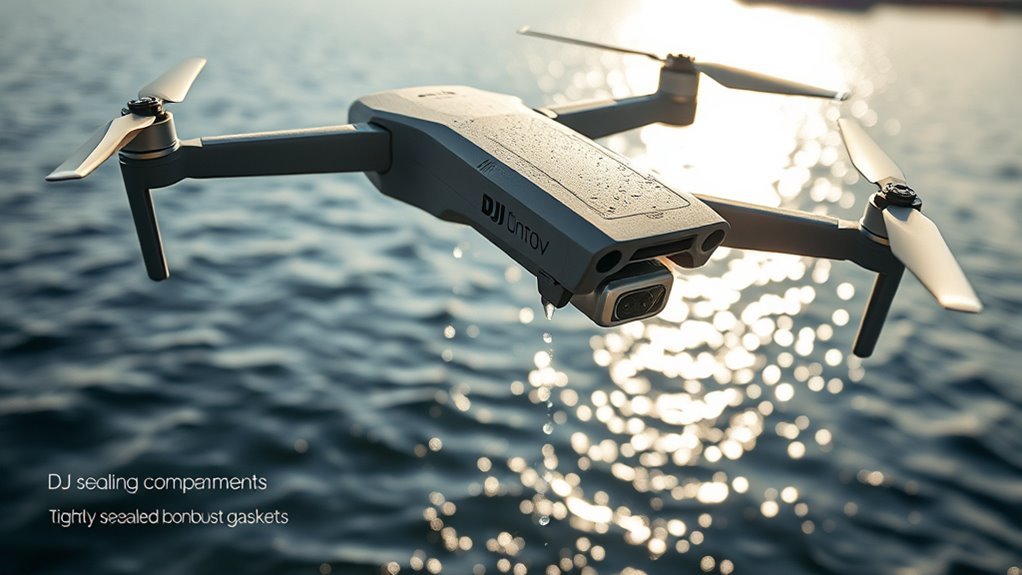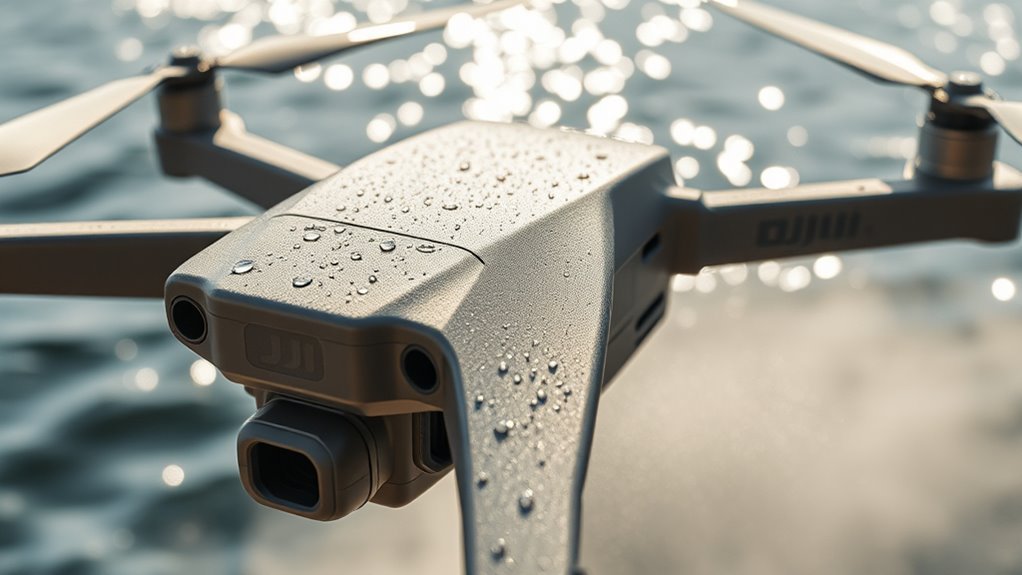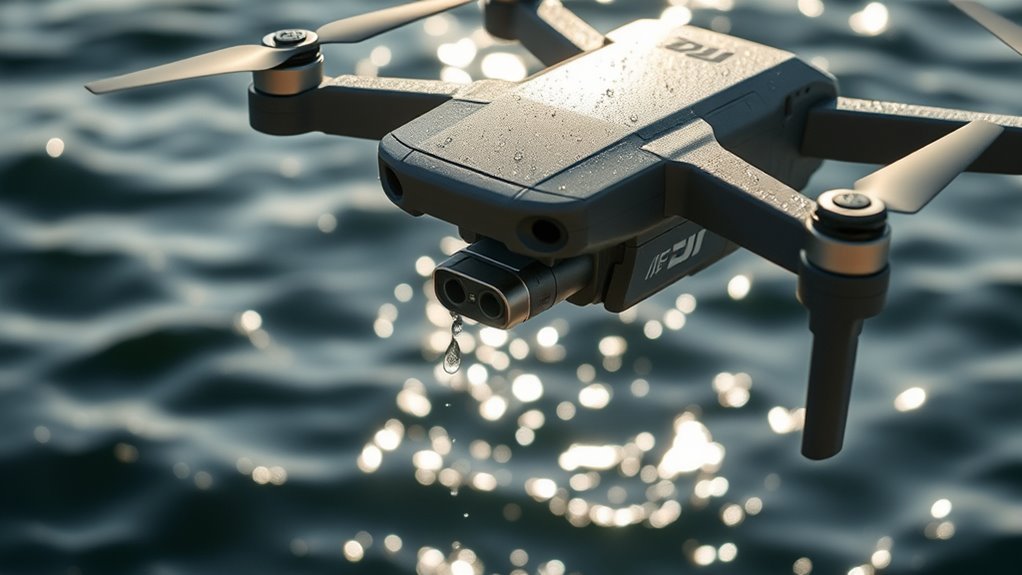You’ll find DJI drones water-resistant thanks to precise sealing techniques, including optimized gaskets around motors and battery compartments that prevent moisture entry. Waterproof coatings like hydrophobic nanolayers repel water at a microscopic level, protecting sensitive electronics without adding weight. Their design features pressure equalization and strategically enclosed components to thwart water ingress. While these measures improve durability, water resistance varies by model and affects performance factors like battery life. Explore further to understand how these intricate engineering choices impact your drone’s usability around water.
Understanding Water Resistance Ratings in DJI Drones

How water-resistant are DJI drones, and what do their ratings really mean for you? Each DJI model undergoes rigorous waterproof testing to determine its resistance level, typically classified by IP (Ingress Protection) ratings. These ratings quantify protection against solids and liquids, revealing drone durability under varied environmental stresses. For example, an IP43 rating implies limited water spray resistance, not full waterproofing. Understanding these distinctions lets you gauge operational limits during rain or near water bodies. DJI drones are generally designed more for water resistance than complete waterproofing, balancing weight and performance. Knowing the exact rating helps you decide if your drone can handle unexpected moisture or if additional precautions are needed, ensuring your freedom to explore without risking costly damage from water exposure.
Sealing Techniques Used in Drone Construction

You’ll find that gasket and seal placement is critical to preventing water ingress in DJI drones, ensuring tight barriers at vulnerable joints. Additionally, specialized waterproof coating materials are applied to sensitive components to repel moisture without hindering functionality. Precision assembly methods further guarantee consistent alignment and compression of seals, maintaining the drone’s overall water resistance.
Gasket and Seal Placement
Three critical areas in DJI drone construction demand meticulous gasket and seal placement to guarantee water resistance: motor housings, battery compartments, and sensor enclosures. In these zones, gasket design is optimized to create continuous barriers against moisture intrusion without compromising the drone’s operational freedom. You’ll notice that seal integrity hinges on precise alignment and compression of gaskets, preventing micro-gap formations that could allow water ingress. DJI employs materials with high elasticity and chemical resistance, ensuring that seals maintain their form under vibration and temperature fluctuations. This strategic placement not only protects sensitive electronics but also preserves aerodynamic efficiency. Understanding this, you can appreciate how each gasket’s position and composition is integral to sustaining water resistance while enabling the drone’s full range of motion and performance in diverse environments.
Waterproof Coating Materials
Although gasket placement forms the backbone of water resistance, waterproof coating materials play an equally essential role in DJI drone construction by providing an additional protective barrier against moisture. These coating innovations utilize advanced waterproof technologies such as hydrophobic nanocoatings and conformal polymer layers. You’ll find these materials selectively applied to critical electronic components and circuit boards, effectively repelling water molecules and preventing short circuits. The coatings maintain drone functionality without adding bulk or compromising aerodynamics, enabling you to fly in damp or rainy conditions confidently. By integrating these coatings at a molecular level, DJI guarantees sustained performance and durability under environmental stress, granting you freedom to explore diverse terrains without frequent maintenance concerns. This precision in waterproof technologies showcases DJI’s commitment to reliability and operational resilience.
Precision Assembly Methods
Building on the role of waterproof coatings, the effectiveness of DJI drones in resisting water also hinges on precision assembly methods. These assembly techniques are integral to the drone’s structural integrity, ensuring tight seals at critical junctures. Advanced manufacturing processes employ automated robotic systems that align components with micrometer accuracy, minimizing gaps where water could penetrate. Specialized sealing materials, such as silicone gaskets and industrial-grade adhesives, are applied strategically during assembly to enhance water resistance without compromising weight or performance. You’ll appreciate how these meticulous manufacturing processes combine with exacting assembly techniques to create a robust barrier against water intrusion, enabling DJI drones to operate freely in diverse environments. This precision not only preserves internal electronics but also extends the drone’s operational lifespan, giving you the freedom to explore without constant worry about water damage.
Use of Waterproof Materials and Coatings

When evaluating DJI drones, you’ll notice they incorporate durable sealing techniques alongside hydrophobic coatings to minimize water ingress. Materials are carefully selected for their corrosion resistance, enhancing longevity in moist environments. Understanding these protective layers helps you assess the drone’s real-world water resistance.
Durable Sealing Techniques
Since drones often encounter moisture in various environments, DJI employs durable sealing techniques that rely on advanced waterproof materials and specialized coatings. These sealing techniques integrate precision-engineered gaskets and O-rings made from resilient elastomers, guaranteeing tight interfaces between components. The use of durable materials like silicone and fluororubber maintains elasticity and resistance under temperature fluctuations and mechanical stress. DJI’s sealing methods also involve meticulous bonding processes, where adhesives form impermeable barriers without compromising structural integrity. This approach minimizes water ingress through seams, buttons, and ports, critical points vulnerable to moisture. By combining these durable materials with engineered sealing techniques, DJI guarantees their drones maintain operational freedom in humid or wet conditions, safeguarding sensitive electronics while allowing you to explore with confidence and reliability.
Hydrophobic Coating Application
Although durable sealing forms the primary defense against moisture, the application of hydrophobic coatings greatly enhances DJI drones’ resistance to water exposure. These coatings create a microscopic barrier that repels water molecules, considerably reducing surface adhesion and preventing moisture ingress. You’ll appreciate how advanced coating techniques, such as plasma spraying or chemical vapor deposition, guarantee uniform coverage on intricate drone components. The hydrophobic benefits extend beyond water resistance—they also minimize dust accumulation and ease cleaning, maintaining peak sensor and motor performance. By integrating these coatings, DJI drones achieve a higher level of environmental resilience without adding bulk or compromising weight. This precise application supports your need for operational freedom, allowing flights in damp or unpredictable conditions with greater confidence and reliability.
Corrosion-Resistant Material Choices
To guarantee DJI drones withstand prolonged exposure to moisture without degradation, selecting corrosion-resistant materials and waterproof coatings is essential. The material selection process prioritizes metals like stainless steel and aluminum alloys, which offer inherent corrosion resistance, ensuring structural integrity over time. Additionally, high-grade polymers and composites are used for their low permeability and resistance to chemical attack. These materials are often paired with specialized waterproof coatings designed to create robust barriers against water intrusion and environmental contaminants. By integrating these corrosion-resistant elements, DJI drones maintain functionality and durability even in challenging conditions. This strategic approach to material selection empowers you to operate freely without worrying about moisture-induced failures, enhancing the drone’s reliability and lifespan during extended outdoor use.
Design Features That Prevent Water Ingress
When you’re evaluating DJI drones for water resistance, understanding their design features that prevent water ingress is vital. DJI integrates advanced waterproof technology and design innovations to guarantee drones withstand moisture exposure without compromising performance. Seals, gaskets, and strategic component placement play critical roles in blocking water entry, allowing you to explore freely.
| Feature | Function |
|---|---|
| Precision Seals | Block water at joints and seams |
| Hydrophobic Coatings | Repel water on external surfaces |
| Enclosed Compartments | Isolate sensitive electronics |
| Pressure Equalization | Prevent moisture buildup inside |
These design elements form a robust barrier against water intrusion, enabling you to operate confidently in damp or unpredictable environments.
Protective Measures for Sensitive Components
Beyond the external design features that mitigate water ingress, protecting the drone’s sensitive internal components requires targeted measures. You’ll find that DJI employs advanced moisture barriers around essential electronics such as circuit boards, sensors, and connectors. These barriers create a sealed environment that limits moisture exposure, critical for maintaining functionality during unpredictable conditions. Additionally, rigorous waterproof testing guarantees each drone meets specified ingress protection standards, validating the effectiveness of these internal safeguards. By integrating conformal coatings and gasket seals, DJI enhances resistance without compromising component accessibility for maintenance. This precise engineering lets you confidently operate your drone near water, knowing fundamental systems remain shielded. Such protective measures provide you freedom to explore diverse environments, minimizing water-induced failures while preserving operational integrity.
Impact of Water Resistance on Drone Performance
Although water resistance enhances a drone’s durability in humid or wet environments, it can influence performance factors such as weight, aerodynamics, and heat dissipation. When you opt for water resistance, expect slight compromises in drone functionality that affect overall water performance. Increased sealing and protective layers add weight, reducing flight time. Aerodynamic profiles may be altered, impacting maneuverability. Thermal management is challenged since enclosed components dissipate heat less efficiently.
| FactorImpact on Drone Performance | |
|---|---|
| Weight | Increased mass lowers flight time |
| Aerodynamics | Modified design affects agility |
| Heat Dissipation | Reduced cooling efficiency |
| Sensor Accuracy | Protective coatings may interfere |
| Battery Life | Slightly decreased under wet load |
Understanding these balances helps you maintain ideal water performance without sacrificing freedom in flight.
Maintenance Tips for Water-Resistant DJI Drones
Proper maintenance of water-resistant DJI drones requires a systematic approach to preserve their seals and electronic integrity. After each flight, especially near water, perform thorough drone cleaning to remove moisture, salt, or debris that could degrade protective coatings or compromise waterproof maintenance. Use a soft, lint-free cloth and avoid harsh chemicals that might erode sealants. Inspect seals and joints for microtears or wear regularly, as these vulnerabilities can allow water ingress. When storing, keep your drone in a dry, temperature-controlled environment to maintain seal elasticity. Charging ports and battery compartments demand special attention; verify they are completely dry before connecting power sources. By adhering to these precise maintenance steps, you’ll maximize your drone’s operational freedom while safeguarding its water-resistant capabilities effectively.
Comparing Water Resistance Across Different DJI Models
When evaluating DJI drones for water resistance, you’ll find that models vary considerably in their protective features and certifications. This water comparison shows that some drone models offer enhanced sealing against moisture, while others rely on splash resistance without full waterproofing. Understanding these distinctions is essential for maximizing operational freedom in wet environments.
- DJI Matrice 300 RTK: IP45 rating, designed for industrial use with robust water resistance.
- DJI Mavic Air 2: No official waterproof rating; limited splash resistance.
- DJI Inspire 2: Minimal water protection, requires careful handling near water.

